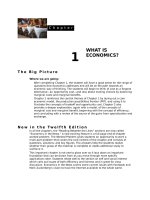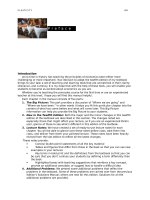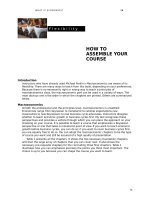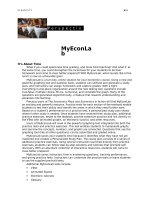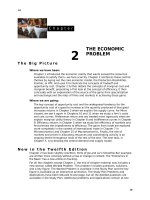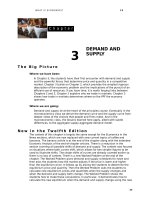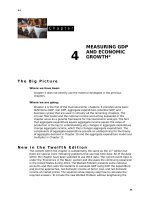Answers to review quizzes marcroeconomics 12e parkin chapter 6
Bạn đang xem bản rút gọn của tài liệu. Xem và tải ngay bản đầy đủ của tài liệu tại đây (175.15 KB, 14 trang )
W H AT I S E C O N O M I C S ?
105
6
ECONOMIC
GROWTH**
Answers to the Review Quizzes
Page 172 (page 580 in Economics)
1.
What is economic growth and how do we calculate its rate?
Economic growth is the sustained expansion of production possibilities. It is
measured by the increase in real GDP over a given time period. The economic
growth rate is the annual percentage change in real GDP.
2.
What is the relationship between the growth rate of real GDP and the growth
rate of real GDP per person?
The growth rate of real GDP tells how rapidly the total economy is expanding while
the growth rate of real GDP per person tells how the standard of living is changing.
The growth rate of real GDP per person approximately equals the growth rate of
real GDP minus the population growth rate.
3.
Use the Rule of 70 to calculate the growth rate that leads to a doubling of
real GDP per person in 20 years.
The rule of 70 states that the number of years it takes for the level of any variable
to double is approximately equal to 70 divided by the growth rate. If the level of
real GDP doubles in 20 years, the rule of 70 gives 20 = 70 ÷ (growth rate) so that
the growth rate equals 70 ÷ 20, which is 3.5 percent per year.
Page 175 (page 583 in Economics)
1.
What has been the average growth rate of U.S. real GDP per person over the
past 100 years? In which periods was growth most rapid and in which periods
was it slowest?
Over the past 100 years, U.S. real GDP per person grew at an average rate of 2
percent per year. Slow growth occurred during mid-1950s and 1973–1983. Very
slow growth (negative growth!) also occurred during the Great Depression. Growth
was rapid during the 1920s and 1960s. Growth was also (extremely!) rapid during
World War II.
2.
Describe the gaps between real GDP per person in the United States and in
other countries. For which countries is the gap narrowing? For which is it
widening? For which is it the same?
105
106
Some rich countries are catching up with the United States, but the gaps between
the United States and many poor countries are not closing. Amongst the rich
countries, since 1960 Japan has closed the gap with the United States but the gaps
between the United States and Canada, and the “Europe Big 4” (France, Germany,
Italy, and the United Kingdom) have tended to remain constant. Other Western
European nations and the former Communist countries of Central Europe have
fallen slightly farther behind the United States. The gap between the United States
and most nations in Africa, and Central and South America has widened. But some
nations in Asia— including Hong Kong, Singapore, Korea, and China—have grown
very rapidly. The gap between these nations and the United States has shrunk;
indeed, Singapore has slightly surpassed the United States and Hong Kong has
virtually tied the United States.
3.
Compare the growth rates in Hong Kong, Korea, Singapore, Taiwan, China, and
the United States. In terms of real GDP per person, how far is China behind
these others?
Since 1960, income per person in the nations of Hong Kong, Singapore, Korea,
Taiwan, and China have grown very rapidly and are rapidly catching up to the
United States. Income per person in Hong Kong is virtually the same as that in the
United States and income per person in Singapore slightly exceeds that in the
United States. Income in Korea also is relatively close. Income in China is the
lowest, though recently China has been growing the most rapidly. China’s level of
income in 2010 is similar to that of Hong Kong in 1976.
Page 181 (page 589 in Economics)
1.
What is the aggregate production function?
The aggregate production function is the relationship that tells us how real GDP
changes as the quantity of labor changes when all other influences on production
remain the same.
2.
What determines the demand for labor, the supply of labor, and labor market
equilibrium?
The demand for labor is the relationship between the quantity of labor demanded
and the real wage rate. A fall in the real wage rate increases the quantity of labor
demanded because of diminishing returns. The demand for labor also depends on
productivity. If productivity increases, the demand for labor increases.
The supply of labor is the relationship between the quantity of labor supplied and
the real wage rate. An increase in the real wage rate increases the quantity of
labor supplied because more people enter the labor force and the hours supplied
per person increases.
The real wage adjusts so that the labor market is in equilibrium. If the real wage
rate is above (below) its equilibrium, there is a surplus (shortage) of labor that
then causes the real wage rate to fall (rise). For example, if the real wage rate is
above the equilibrium level, there is a surplus of labor so the real wage rate falls
until it reaches its equilibrium. The equilibrium quantity of employment is the full
employment quantity of labor.
3.
What determines potential GDP?
Potential GDP is determined from the labor market equilibrium. When the labor
market is in equilibrium, there is full employment. The quantity of real GDP
produced by the full employment quantity of labor is potential GDP.
106
W H AT I S E C O N O M I C S ?
4.
107
What are the two broad sources of potential GDP growth?
The two broad sources of growth in potential GDP are growth of the supply of labor
and growth of labor productivity.
5.
What are the effects of an increase in the population on potential GDP, the
quantity of labor, the real wage rate, and potential GDP per hour of labor?
An increase in population increases the supply of labor. Employment increases and
the real wage rate falls. The increase in employment creates a movement along
the aggregate production function so potential GDP increases. Because of
diminishing returns, potential GDP per hour of labor decreases.
6.
What are the effects of an increase in labor productivity on potential GDP, the
quantity of labor, the real wage rate, and potential GDP per hour of labor?
The increase in labor productivity shifts the aggregate production function curve
upward. The demand for labor increases, and the demand for labor curve shifts
rightward. The increase in the demand for labor raises the real wage rate and
increases employment. The increase in employment as well as the upward shift of
the aggregate production function increase potential GDP. Potential GDP per hour
of labor increases.
Page 183 (page 591 in Economics)
1.
What are the preconditions for labor productivity growth?
The fundamental preconditions for labor productivity growth are the existence of:
firms, markets, property rights, and money. These fundamental preconditions
create an incentive system that can lead to labor productivity growth.
2.
Explain the influences on the pace of labor productivity growth.
Once the preconditions for growth are in place, the sources of labor productivity
growth are: physical capital growth, human capital growth, and advances in
technology. All of these activities enable an economy to grow and they all increase
labor productivity. They all also interact: human capital creates new technologies,
which are then embodied in both new human capital and new physical capital.
Similarly advances in technology also lead to increases in labor productivity.
Page 189 (page 597 in Economics)
1.
What is the key idea of classical growth theory that leads to the dismal
outcome?
The “dismal outcome” in classical theory is the conclusion that in the long run real
GDP per person equals the subsistence level. In classical growth theory, an
increase in real GDP per person causes population increases that return real GDP
per person to the subsistence level. In the classical growth theory, an increase in
income creates a population boom. The increase in population increases the
supply of labor. Because of diminishing returns to labor, the increase in the supply
of labor lowers the real wage rate and people’s incomes. Eventually the real wage
rate falls to equal the subsistence level, at which time the population stops
growing.
2.
What, according to neoclassical growth theory, is the fundamental cause of
economic growth?
In neoclassical growth theory, growth results from technological advances, which are
determined by chance.
107
108
3.
What is the key proposition of new growth theory that makes economic
growth persist?
The key proposition that makes growth persist indefinitely in the new growth
theory is the assumption that the returns to knowledge and human capital do not
diminish. As a result, increases in knowledge do not cause diminishing returns and
the incentive to innovate remains high. As people accumulate more knowledge,
the incentive to innovate does not fall and so people continue to innovate new and
better ways to produce new and better products. This innovation means that
economic growth persists indefinitely.
108
Answers to the Study Plan Problems and
Applications
1.
Brazil’s real GDP was 1,180 trillion reais in 2013 and 1,202 trillion reais in
2014. Brazil’s population was 198 million in 2013 and 200 million in 2014.
Calculate
a. The growth rate of real GDP.
The economic growth rate is the growth rate of real GDP. Between 2013 and 2014
this growth rate equals [(1,202 trillion reais − 1,180 trillion reais)/1,180 trillion
reais] × 100, which is 1.9 percent.
b. The growth rate of real GDP per person.
Brazil’s population grew at [(200 million − 198 million)/198 million] × 100, which is
1.0 percent. Brazil’s economic growth rate is 1.9 percent, so the growth rate of real
GDP per person is 1.9 percent − 1.0 percent, or 0.9 percent.
c. The approximate number of years it takes for real GDP per person in Brazil
to double if the 2014 growth rate of real GDP and the population growth rate
are maintained.
Brazil’s real GDP per person is growing at 0.9 percent a year. The rule of 70 tells us
that Brazil’s real GDP per person will double in 70/0.9 = 77.8 years.
2.
China’s real GDP per person was 13,165 yuan in 2013 and 14,088 yuan in
2014. India’s real GDP per person was 49,516 rupees in 2013 and 51,521
rupees in 2014. By maintaining their current growth rates, which country will
be the first to double its standard of living?
China’s growth rate of real GDP per person is [(16,010 yuan − 15,040 yuan)/15,040
yuan] × 100, which is 6.4 percent. India’s growth rate of real GDP per person is
[(56,840 rupees − 54,085 rupees)/54,085 rupees] × 100, which is 5.1 percent.
China’s real GDP per person will double in approximately 70/6.4 = 10.9 years and
India’s real GDP per person will double in approximately 70/5.1 = 13.7 years, so
China’s standard of living will double first.
3.
China was the largest economy for centuries because everyone had the same
type of economy—subsistence—and so the country with the most people
would be economically biggest. Then the Industrial Revolution sent the West
on a more prosperous path. Now the world is returning to a common
economy, this time technology- and information-based, so once again
population triumphs.
a. Why was China the world’s largest economy until 1890?
GDP equals GDP per person multiplied by the number of people. Until 1890 most
people in the world had approximately the same subsistence level of income so
that every nation’s GDP per person was about the same. Because China had, by
far, the world’s largest population, China also had the world’s largest GDP.
b. Why did the United States surpass China in 1890 to become the world’s
largest economy?
The United States benefited from the industrial revolution that was sweeping
Western nations at the time while China did not. U.S. economic growth accelerated
well beyond Chinese economic growth so that the U.S. GDP became larger than
China’s GDP.
78
CHAPTER 6
Use the following tables to work Problems 4 to 6.
The first table describes an economy’s labor market in 2014 and the second table
describes its production function in 2014.
Real wage rate
(dollars per
hour)
80
70
60
50
40
30
20
4.
Labor
hours
supplied
45
40
35
30
25
20
15
Labor
hours
demanded
5
10
15
20
25
30
35
Labor
(hours)
5
10
15
20
25
30
35
40
Real GDP
(2009
dollars)
425
800
1,125
1,400
1,625
1,800
1,925
2,000
What are the equilibrium real wage rate, the quantity of labor employed in
2014, labor productivity, and potential GDP in 2014?
The equilibrium real wage rate is $40 per hour and the equilibrium quantity of
labor employed is 25 hours. With employment of 25 hours, the production function
shows that potential GDP is $1,625. Labor productivity equals $1,625 ÷ 25 hours,
or $65.00 per hour.
5.
In 2015, the population increases and labor hours supplied increase by 10 at
each real wage rate. What are the equilibrium real wage rate, labor
productivity, and potential GDP in 2015?
The equilibrium real wage rate is $30 per hour and the equilibrium quantity of
employment is 30 hours. With employment of 30 hours, the production function
shows that real GDP is $1,800. Labor productivity equals $1,800 ÷ 30 hours, or
$60.00 per hour.
6.
In 2015, the population increases and labor hours supplied increase by 10 at
each real wage rate. Does the standard of living in this economy increase in
2015? Explain why or why not.
The standard of living does not increase. In fact, it decreases because real GDP per
person falls. The economy moves along its production function so that potential
GDP increases but real GDP per person decreases.
7.
Labor Productivity on the Rise
The BLS reported the following data for the year ended June 2009: In the
nonfarm sector, output fell 5.5 percent as labor productivity increased 1.9
percent—the largest increase since 2003—but in the manufacturing sector,
output fell 9.8 percent as labor productivity increased by 4.9 percent—the
largest increase since the first quarter of 2005.
Source: bls.gov/news.release, August 11, 2009
In both sectors, output fell while labor productivity increased. Did the quantity
of labor (aggregate hours) increase or decrease? In which sector was the
change in the quantity of labor larger?
Labor productivity equals output divided by labor hours, so labor hours equals
output divided by labor productivity. In terms of growth rates, this last formula
means that the growth in labor hours approximately equals the growth in output
minus the growth in labor productivity. (This is the same calculation as on page
578 of the text for the approximation formula for growth in real GDP per person.)
ECONOMIC GROWTH
Using this equation, in the nonfarm sector labor hours fell by −5.5 percent – 1.9
percent = −7.4 percent and in the manufacturing sector labor hours fell by −9.8
percent – 4.9 percent = −14.7 percent. The change in labor was the largest in the
manufacturing sector.
8.
Explain the processes that will bring the growth of real GDP per person to a
stop according to
a. Classical growth theory.
According to the classical theory, population growth continues at a rapid pace as
long as real GDP per person exceeds the subsistence level. With population growth,
the supply of labor increases and diminishing returns lowers real GDP per person.
Eventually real GDP per person equals the subsistence amount, at which time
economic growth ends.
b. Neoclassical growth theory.
In the neoclassical model, technological growth leads to increased saving so that
capital accumulates and real GDP per person grows. When technological growth
stops, capital continues to accumulate but diminishing marginal returns drives the
return on capital lower and so decreases investment and saving. Eventually the
capital stock stops growing and economic growth stops.
c. New growth theory.
According to the new growth theory, economic growth will not stop.
79
80
CHAPTER 6
Answers to Additional Problems and Applications
9.
In 2013, Turkey’s real GDP was growing at 4.1 percent a year and its
population was growing at 1.26 percent a year. If these growth rates
continued, in what year would Turkey’s real GDP per person be twice what it
is in 2013?
The growth rate of real GDP per person is equal to the growth rate of real GDP
minus the population growth rate. Thus, it is equal to 4.1 − 1.26 = 2.84 percent.
The rule of 70 states that the number of years it takes for the level of any variable
to double is approximately equal to 70 divided by the growth rate. Using the rule of
70, Turkey’s real GDP per person will double in 70/2.84 = 24.65 years.
10.
Turkey’s real GDP (in U.S. dollars) was $788.9 billion in 2012 and $822.1
billion in 2013. Turkey’s population was 74 million in 2012 and 74.93 million in
2013. Calculate
a. The growth rate of GDP.
The growth rate of GDP is the percentage change in GDP. It is equal to [(822.1 −
788.9)/788.9] × 100 = 4.21 percent.
b. The growth rate of real GDP per person.
Turkey’s population grew at [(74.93 million − 74 million)/74 million] × 100, which is
1.26 percent. Turkey’s growth rate of real GDP is 4.21 percent, so the growth rate
of real GDP per person is 4.21 percent − 1.26 percent, or 2.95 percent.
c. The approximate number of years it takes for GDP per person in Turkey to
double if the 2013 growth rate of GDP and the population growth rate are
maintained.
Turkey’s real GDP per person is growing at 2.95 percent a year. The rule of 70 tells
us that Turkey’s real GDP per person will double in 70/2.95 = 23.72 years.
11.
Russia’s real GDP (in U.S. dollars) was $2.017 trillion in 2012 and $2.097
trillion in 2013. Russia’s population was 143.2 million in 2012 and 143.5
million in 2013. Calculate
a. The growth rate of real GDP.
The growth rate of real GDP between 2011 and 2012 equals [($2.097trillion −
$2.017 trillion)/$2.097 trillion] × 100 = 3.97 percent.
b. The growth rate of real GDP per person.
Russia’s population growth rate is equal to [(143.5 million − 143.2 million)/ 143.2
million] × 100, which is 0.21 percent. Russia’s economic growth rate is 3.97
percent, so the growth rate of real GDP per person is 3.97 percent − 0.21 percent,
or 3.76 percent.
c. The approximate number of years it will take for real GDP per person in
Russia to double if the current growth rate of real GDP is maintained.
Russia’s real GDP per person is growing at 3.76 percent a year. The rule of 70 tells
us that Russia’s real GDP per person will double in 70/3.76 = 18.61 years.
ECONOMIC GROWTH
12.
The New World Order
While gross domestic product growth is picking up a bit in emerging market
economies, it is picking up even more in the advanced economies. Real GDP
in the emerging market economies is forecasted to grow at 5.4% in 2015 up
from 4.9% in 2012. In the advanced economies, real GDP is expected to grow
at 2.3% in 2015 up from 1.4% in 2012. The difference in growth rates means
that the large spread between emerging market economies and advanced
economies of the past 40 years will continue for many more years.
Source: World Economic Outlook, January, 2014
Do growth rates over the past few decades indicate that gaps in real GDP per
person around the world are shrinking, growing, or staying the same? Explain.
Gaps with a few countries are shrinking but for the most part gaps are remaining
more or less the same. The gaps between U.S. real GDP per person and real GDP
per person in a few Asian countries, such as Hong King, Singapore, Taiwan, Korea,
and China have narrowed sharply over the last 40 years. But the gaps between
U.S. real GDP per person and real GDP per person in Canada, Europe, Japan (since
1970), and Central and South America have remained roughly constant over the
past decades. And the gap between U.S. real GDP per person and real GDP per
person in Africa has widened slightly since 1960. The data in the news clip
indicates that the gap between the advanced economies and the emerging market
economies will decrease a bit in 2015.
13.
If a large increase in investment increases labor productivity, explain what
happens to
a. Potential GDP.
The production function curve shifts upward and equilibrium employment
increases, both of which increase potential GDP.
b. Employment.
Employment increases. The demand for labor increases, which increases
equilibrium employment.
c. The real wage rate.
The real wage rate rises. The demand for labor increases, which raises the
equilibrium real wage rate.
14.
If a severe drought decreases labor productivity, explain what happens to
a. Potential GDP.
The production function curve shifts downward and equilibrium employment
decreases, both of which decrease potential GDP.
b. Employment.
Employment decreases. The demand for labor decreases, which decreases
equilibrium employment.
c. The real wage rate.
The real wage rate falls. The demand for labor decreases, which lowers the
equilibrium real wage rate.
81
82
CHAPTER 6
Use the following tables to work Problems 15 to 17.
The first table describes an economy’s labor market in 2014 and the second table
describes its production function in 2014.
Real wage rate
(dollars per
hour)
80
70
60
50
40
30
20
15.
Labor
hours
supplied
55
50
45
40
35
30
25
Labor
hours
demanded
15
20
25
30
35
40
45
Labor
(hours)
15
20
25
30
35
40
45
50
Real GDP
(2009
dollars)
1,425
1,800
2,125
2,400
2,625
2,800
2,925
3,000
What are the equilibrium real wage rate and the quantity of labor employed
in 2014?
The equilibrium real wage rate is $40 per hour and the equilibrium quantity of
labor employed is 35 hours.
16.
What are labor productivity and potential GDP in 2014?
Potential GDP is $2,625, the quantity of real GDP produced with the equilibrium
quantity of employment. Labor productivity equals $2,625 ÷ 35 hours, or $75.00
per hour.
17.
Suppose that labor productivity increases in 2014.What effect does the
increased labor productivity have on the demand for labor, the supply of
labor, potential GDP, and real GDP per person?
The increase in labor productivity increases the demand for labor. The supply of
labor does not change. The equilibrium wage rate rises and equilibrium
employment increases. Potential GDP increases for two reasons: First, the increase
in labor productivity increases potential GDP; second, the increase in equilibrium
employment increases potential GDP. Real GDP per person increases.
18.
India’s Economy Hits the Wall
Just six months ago, India was looking good. Annual growth was 9%,
consumer demand was huge, and foreign investment was growing. But now
most economic forecasts expect growth to slow to 7%—a big drop for a
country that needs to accelerate growth. India needs urgently to upgrade its
infrastructure and education and health-care facilities. Agriculture is
unproductive and needs better technology. The legal system needs to be
strengthened with more judges and courtrooms.
Source: BusinessWeek, July 1, 2008
Explain five potential sources for faster economic growth in India suggested
in this news clip.
One suggested source of increased economic growth is increased infrastructure
investment. Infrastructure includes factors such as roads, ports, railways, and
electricity transmission. The second suggestion mentioned is to raise education
achievement. This recommendation, while not a short-term fix, would be quite
powerful at raising India’s long-term growth. The third factor is to increase healthcare facilities. Better health care for its citizens translates into increased labor
productivity because India’s workers would be better able to work in the
ECONOMIC GROWTH
marketplace. The fourth source of increased economic growth is to increase
productivity in agriculture. This suggestion, however, is not well detailed; in
particular, it is much easier to suggest raising productivity than to actually do so.
The last suggestion is to increase the number of judges and strengthen the legal
system, and improve governance. However, while a seemingly simple suggestion,
this process is likely to wind up politically quite difficult.
19.
Has The Ideas Machine Broken Down?
According to Robert Gordon, the last two centuries of economic growth might
actually amount to just “one big wave” of dramatic change rather than a new
era of interrupted progress, and that the world is returning to extensive
growth, which is a matter of adding more and/or better labor, capital, and
resources.
Source: The Economist, January 12, 2013
Which of the growth theories that you studied in this chapter best
corresponds to the argument advanced by Mr. Gordon?
Neoclassical growth theory best corresponds to the argument advanced by
Gordon. According to this theory, technological change, which influences the
economic growth rate, results from chance. When we are lucky, we have rapid
technological change, and when bad luck strikes, the pace of technological
advance slows.
20.
Is faster economic growth always a good thing? Argue the case for faster
growth and the case for slower growth. Then reach a conclusion on whether
growth should be increased or slowed.
More rapid economic growth brings increased consumption possibilities in the
future, which is the benefit from economic growth. Economic growth has costs:
Decreased current consumption and the possibility of increased resource depletion
and environmental damage. (Of course, the technological change that results from
economic growth might allow for less resource depletion and less environmental
damage.) Whether economic growth should be increased or decreased depends on
the benefits of more rapid growth relative to the costs of more rapid growth.
21.
For Economist Paul Romer, Prosperity Depends on Ideas
According to Romer, ideas and technological discoveries unlock the mystery
of growth. He argues that ideas, especially those that can be contained in a
piece of software, codified in a chemical formula, or used to improve
organization of an assembly line, don’t obey the law of diminishing returns.
Ideas and knowledge build on each other and can be reproduced cheaply.
Computers, networks, and software serve as his best illustrations of how
ideas create prosperity.
Source: The Wall Street Journal, January 21, 1997
Explain which growth theory best describes the news clip.
The new growth theory stresses the role of innovation and the birth of new firms
and the death of old ones. The new growth theory best corresponds to the article
because it describes the impact of ideas and technological discoveries on the
economy. If these ideas and discoveries are successful, then new firms that use
these ideas and produce novel products will be born and old firms that produce
outdated products will die. The news clip also conveys that new technology will
lead to prosperity and more profits.
83
84
CHAPTER 6
Economics in the News
22.
After you have studied Economics in the News on pp. 190–191 (598–599 in
Economics), answer the following questions.
a. How do economic growth rates of South Africa and Botswana compare?
Botswana’s economic growth rate has been much higher than South Africa’s
economic growth rate.
b. For South Africa to grow faster, how would the percentage of GDP invested
in new capital need to change?
The percent of GDP invested in new capital needs to increase.
c. If South Africa is able to achieve a growth rate of 8 percent per year, in how
many years will real GDP have doubled?
The rule of 70 shows that South Africa’s GDP will double in approximately 70/8.0 ,
which is 8.75 years.
d. Describe the policies proposed by the author of the news article and explain
how they might change labor productivity.
There are a variety of proposals designed to increase labor productivity. These
proposals include (1) reforming labor laws by removing the automatic extension of
collective bargaining agreements across sectors; (2) establishing “jobs zones” that
feature special exemptions from restrictive regulations; (3) lifting administrative
requirements for small businesses; (4) creating a youth wage subsidy and marketdriven skills development programs; (5) distributing shares in state-owned
companies; (6) introducing tax deductions to incentivize employee sharedownership schemes; and, (7) promoting joint ownership in the agricultural sector.
The first three proposals aim to increase labor productivity by decreasing rigidities
in the labor market that prevent workers from being allocated to their highestvalued jobs. The fourth proposal aims to increase labor productivity by boosting
workers’ human capital. The last three proposals attempt to increase labor
productivity by changing the incentives of managers to a more profit-driven goal,
which increases their incentives to boost their workers’ productivity.
e. What is the source of Botswana’s growth success story and what must South
Africa do to replicate that success?
Botswana has secure property rights and invests a very large proportion of its GDP.
South Africa must increase the growth of its capital, both physical capital and
human capital. South Africa must increase the growth rate of its labor productivity.
It also needs to make property rights secure.
ECONOMIC GROWTH
f.
Draw a PPF graph to show what has
happened in Botswana and South
Africa since 1980.
Figure 6.1 shows the PPFs of Botswana
and South Africa in 1980 and 2012. In
1980, South Africa’s PPF lay beyond
Botswana’s PPF. But in the intervening
years, Botswana has grown more rapidly
so that its GDP has overtaken that in
South Africa and so that now, as
illustrated in the figure, Botswana’s PPF
lies beyond South Africa’s PPF.
23.
Make Way for India—The Next China
China grows at around 9 percent a year, but its one-child policy will start to
reduce the size of China’s working-age population within the next 10 years.
India, by contrast, will have an increasing working-age population for another
generation at least.
Source: The Independent, March 1, 2006
a. Given the expected population changes, do you think China or India will
have the greater economic growth rate? Why?
Economic growth occurs because labor productivity grows and because the
population grows. If labor productivity grows at the same rate in China as in India,
then the more rapid population growth in India will lead to more rapid economic
growth in India.
b. Would China’s growth rate remain at 9 percent a year without the restriction
on its population growth rate?
According to the classical theory of economic growth, restricting population growth
is necessary for persisting economic growth. According to the new growth theory,
restricting population growth leads to slower economic growth. So whether China’s
growth would remain at 9 percent a year without restricting population growth is
not clear.
c. India’s population growth rate is 1.6 percent a year, and in 2005 its
economic growth rate was 8 percent a year. China’s population growth rate
is 0.6 percent a year, and in 2005 its economic growth rate was 9 percent a
year. In what year will real GDP per person double in each country?
India’s growth in real GDP per person equals 8 percent a year minus 1.6 percent a
year, which is 6.4 percent a year. According to the Rule of 70, at this rate India’s
real GDP per person will double in 70/6.4, which is 10.9 years. So India’s real GDP
per person will double by 2016.
China’s growth in real GDP per person equals 9 percent a year minus 0.6 percent a
year, which is 8.4 percent a year According to the Rule of 70, at this rate China’s
85
86
CHAPTER 6
real GDP per person will double in 70/8.4, which is 8.3 years. So China’s real GDP
per person will double in 2014.


